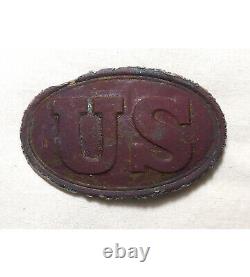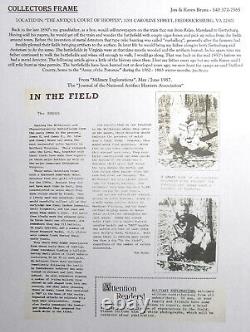
- Homepage
- Binding
- 1 / 2 Leather (2)
- 3 / 4 Leather (2)
- Brochure / Pamphlet (4)
- Cloth (87)
- Disbound (3)
- Fine Binding (52)
- Hard Back (2)
- Hard Cover (4)
- Hardback (6)
- Hardcover (887)
- Hardcover Sheepskin (2)
- Hardcover W / Jacket (5)
- Hardcovers (2)
- Leather (248)
- Original Blue Cloth (2)
- Quarter Leather (3)
- Softcover (3)
- Softcover, Wraps (41)
- ... (3517)
- Composition
- Language
- Region
- Theme
- Topic
- American (us) (22)
- American Civil War (14)
- American History (4)
- Atlases (4)
- Bible (5)
- Christianity, Bibles (85)
- Christmas (4)
- Civil War (50)
- Civil War (1861-65) (890)
- Classics (6)
- Essays & Speeches (3)
- Historical (34)
- Literature (5)
- Military (24)
- Plantation Life (6)
- Reference (3)
- Religion (6)
- The Civil War (4)
- U.s. Grant (13)
- United States (30)
- ... (3660)
28th New York Infantry U. S. Belt Buckle Civil War Artifact 5180






Belt plate excavated from the 28th New York Infantry's 1862 regimental winter camp at Fairfax Station in Virginia. The oval plate is an early type buckle called a "puppy paw" with the rounded studs on the back. Most of this type were made prewar and worn by state militia groups. Waist plates were mounted on leather belts worn outside of the jacket to hold the cartridge box, cap box, and other accoutrements. The main stud is missing.
The camp was located off the Ox Road a little south of the Station itself. The 28th New York and the 5th Connecticut Infantry were camped side by side there. The last battle of the 28th was at Chancellorsville, in which the regiment lost 78 members killed, wounded or missing. The 28th New York Infantry was organized in Albany, New York, and was mustered in for a two-year enlistment on May 22, 1861. At Antietam the command was closely engaged and later went into camp at Harper's Ferry.
On December 10, 1862 the regiment marched to Fairfax Station where they built log huts next to its sister regiment the 5th Connecticut Infantry. The regiment received orders to guard Fairfax Station, a supply depot, against a perceived attack from Confederate cavalry. The weather was so severe that the building of log cabins was necessary. The regiment spent Christmas here, but, on December 28th was again ordered to march back to Dumfries.
Confederate cavalry under General Stuart were raiding around the Union army and this move was carried out in an effort to intercept the raid. However, the move proved unsuccessful and the following day the regiment was ordered to return to Fairfax where they reoccupied the log cabins which they had left on the 28th. Three weeks were spent at Fairfax during which time the regiment reviewed for Generals Williams and Slocum.
On January 19th, 1863, the regiment was ordered to march to Stafford Court House. The history of the 10th Maine makes reference to an event which took place on in March 1863. Having completed a dress parade, the 28th New York and 5th Connecticut started a snowball fight and, assuming it was a free fight, the 128th Pa joined in. However, the two veteran regiments decided to ally against the 128th Pa. As the 128th was commanded by a former officer of the 46th Pa.That regiment came to the assistance of the 128th Pa to the point that most of the brigade was involved in the snowball fight. Colonel Matthews, of the 128th Pa, believing that the proceedings was being taken too seriously, tried to stop the snowball fight and was promptly showered in snowfalls. When General Knipe was summoned, he to was pelted with snowballs but was able to put a stop to the engagement. The buckle measures 2 1/8" x 3 3/8". One stud missing The artifact comes as shown in a 5" x 6" riker style case.
All of the artifacts are guaranteed to be original as stated. Please see our "About" for more information on the framing and artifacts.
